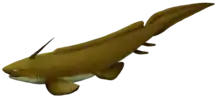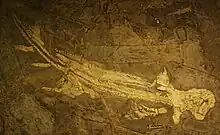Xenacanthida
Xenacanthida (or Xenacanthiforms) is a super-order of extinct shark-like chondrichthyans known from the Carboniferous to Triassic. They were native to freshwater, marginal marine and shallow marine habitats.[1] Some xenacanths may have grown to lengths of 5 m (16 ft).[2] Most xenacanths died out at the end of the Permian in the End-Permian Mass Extinction, with only a few forms surviving into the Triassic.
| Xenacanthida Temporal range: | |
|---|---|
 | |
| Life restoration of Xenacanthus | |
 | |
| Fossil of Orthacanthus senckenbergianus | |
| Scientific classification | |
| Domain: | Eukaryota |
| Kingdom: | Animalia |
| Phylum: | Chordata |
| Class: | Chondrichthyes |
| Subclass: | Elasmobranchii |
| Order: | †Xenacanthida Glikman, 1964 |
| Families and genera | |
|
See text | |
Description
The foundation of the tooth is prolonged lingually with a circlet button and a basal tubercle on the oral and aboral surfaces individually. Xenacanthida's teeth are famed by articulated bones, cephalic vertebrae and isolated teeth and found global in each aquatic and clean environment. The family Xenacanthidae consist of five genera that are Xenacanthus, Triodus, Plicatodus, Mooreodontus and Wurdigneria; all of these are distinguished by cross sections of the points, crown center, length of the median edge, type of vertical cristae, and microscopic anatomy. These kinds of fishes are largely marked from Paleozoic remains and their diversity cut drastically throughout the period of their extinction.
Xenacanths are divided into two groups based on dental characteristics. Group one has tricuspid crown containing two stout, slightly diverging lateral cusps pointing in the same direction, a high median cusp, with a crown-base angle almost at 90 degrees, a large, rounded, apical button with several foramina and multiple, 8-9 coarse vertical cristae on all the cusps. Group two has bicuspid crowns with two upright, asymmetric cusps, where the medial cusp is thicker than the distal one, and consistently lacks a median cusp.[3]
The bodies of xenacanths are elongate and eel-like.[4] Xenacanths had long dorsal fins, as well as a large spine projecting from the top of the head, which was a modified dorsal-fin spine. The spine is usually thought to have acted as a defense against attackers.[2] They also bore two anal fins, with the tail (caudal) fin being pseudo-diphycercal.[4]
Some xenacanths like Barbclabornia, are thought to have reached lengths of 4.5–5 metres (15–16 ft).[2] While others such as Triodus were only around 0.5 metres (1.6 ft) long.[5]
Ecology
Many xenacanths are thought to have been euryhaline and to have migrated between freshwater and marine environments. Orthacanthus platypternus is suggested to have been catadromous, migrating into freshwater environments as a juvenile before returning to the sea as an adult.[2] Based on isotope analysis of teeth, some xenacanths have been suggested to have lived permanently in freshwater environments.[6][7] However, this proposal has been criticised, as the mineralization window of individual teeth only spans a short interval of time of days to weeks, and may not be reflective of long term behaviour.[2] A number of xenacanths are likely to have been fully marine, such as the small primitive genus Bransonella, which is thought to have had a seafloor dwelling (benthic) ecology similar to that of a modern catshark.[8]
The diet of freshwater xenacanths is known to have included temnospondyl amphibians[5] as well as palaeoniscid fish,[9] acanthodians, and other xenacanths.[8] Large xenacanths are suggested to have acted as the apex predators of late Paleozoic freshwater ecosystems, such as the Early Permian freshwater lakes of the Saar–Nahe Basin in southern Germany.[5][8]
Taxonomy
Xenacanths are typically placed as stem-group elasmobranchs, more closely related to modern sharks and rays than to Holocephali, which includes chimaeras.[10][11][12]
Subdivisions
- Order: Bransonelliformes Hampe & Ivanov, 2007
- Genus: Barbclabornia Johnson, 2003 (Early Permian, possibly also Late Carboniferous, North America)
- Genus: Bransonella Harlton, 1933 (Early Carboniferous-Middle Permian, Worldwide)
- Order: Xenacanthiformes Berg, 1955
- Family: Diplodoselachidae Dick, 1981
- Genus: Diplodoselache Dick, 1981 (Early Carboniferous, Europe)
- Genus: Dicentrodus Traquair, 1888 (Early Carboniferous, Europe, North America)
- Genus: Hagenoselache Hampe & Heidkte, 1997 (mid-Carboniferous, Europe)
- Genus: Hokomata Hodnett & Elliott, 2018 (mid-Carboniferous, North America)
- Genus: Lebachacanthus Soler-Gijon, 1997 (Late Carboniferous-Early Permian, Europe)
- Genus: Reginaselache Turner & Burrow, 2011 (Early Carboniferous, Australia)
- Family: Sphenacanthidae Maisey, 1982
- Genus: Sphenacanthus Agassiz, 1837 (Early Carboniferous-Late Permian, Worldwide)
- Genus: Xenosynechodus Agassiz, 1980 (Middle-Late Permian, Europe, later authors have rejected its placement as a xenacanth[13])
- Genus: Desinia Ivanov, 2022[13] (Middle-Late Permian, Europe)
- Family: Orthacanthidae Heyler & Poplin 1989
- Genus: Orthacanthus Agassiz, 1843 (Late Carboniferous-Early Permian, Europe, North America)
- Family: Xenacanthidae Fritsch, 1889
- Genus: Mooreodontus Ginter et al., 2010 (Middle-Late Triassic, Worldwide)
- Genus: Plicatodus Hampe, 1995 (Late Carboniferous-Early Permian, Europe)
- Genus: Triodus Jordan, 1849 (Late Carboniferous-Middle Permian, Europe, North America, South America)[14]
- Genus: Xenacanthus Beyrich, 1848 (Carboniferous-Permian, Worldwide)
- Genus: Wurdigneria Richter, 2005 (Middle-Late Permian, South America)
- incertae sedis
- Genus: Tikiodontus Bhat, Ray & Datta, 2018 (Late Triassic, India)
- Family: Diplodoselachidae Dick, 1981
References
- Pauliv, Victor E.; Martinelli, Agustín G.; Francischini, Heitor; Dentzien-Dias, Paula; Soares, Marina B.; Schultz, Cesar L.; Ribeiro, Ana M. (December 2017). "The first Western Gondwanan species of Triodus Jordan 1849: A new Xenacanthiformes (Chondrichthyes) from the late Paleozoic of Southern Brazil". Journal of South American Earth Sciences. 80: 482–493. doi:10.1016/j.jsames.2017.09.007.
- Beck, Kimberley G.; oler-Gijón, Rodrigo; Carlucci, Jesse R.; Willis, Ray E. (December 2014). "Morphology and Histology of Dorsal Spines of the Xenacanthid Shark Orthacanthus platypternus from the Lower Permian of Texas, USA: Palaeobiological and Palaeoenvironmental Implications". Acta Palaeontologica Polonica. 61 (1): 97–117. doi:10.4202/app.00126.2014
- Bhat, M. S., Ray, S., & Datta, P. (2018). A new assemblage of freshwater sharks (Chondrichthyes: Elasmobranchii) from the Upper Triassic of India. Geobios, 51(4), 269-283. doi:10.1016/j.geobios.2018.06.004
- Soler-Gijón, Rodrigo; Ruiz, Antonio Díez (2023-06-20). ""Carbonífero de Puertollano" Natural Monument (Puertollano basin, Spain): a window for the knowledge of Early Vertebrates". Spanish Journal of Palaeontology. 38 (1): 81–94. doi:10.7203/sjp.26788. ISSN 2660-9568.
- Kriwet, Jürgen; Witzmann, Florian; Klug, Stefanie; Heidtke, Ulrich H.J (2008-01-22). "First direct evidence of a vertebrate three-level trophic chain in the fossil record". Proceedings of the Royal Society B: Biological Sciences. 275 (1631): 181–186. doi:10.1098/rspb.2007.1170. ISSN 0962-8452. PMC 2596183. PMID 17971323.
- Fischer, Jan; Schneider, Jörg W.; Hodnett, John-Paul M.; Elliott, David K.; Johnson, Gary D.; Voigt, Silke; Joachimski, Michael M.; Tichomirowa, Marion; Götze, Jens (2014-11-02). "Stable and radiogenic isotope analyses on shark teeth from the Early to the Middle Permian (Sakmarian–Roadian) of the southwestern USA". Historical Biology. 26 (6): 710–727. doi:10.1080/08912963.2013.838953. ISSN 0891-2963. S2CID 128991144.
- Fischer, Jan; Schneider, Jörg W.; Voigt, Silke; Joachimski, Michael M.; Tichomirowa, Marion; Tütken, Thomas; Götze, Jens; Berner, Ulrich (2013-03-29). "Oxygen and strontium isotopes from fossil shark teeth: Environmental and ecological implications for Late Palaeozoic European basins". Chemical Geology. 342: 44–62. doi:10.1016/j.chemgeo.2013.01.022. ISSN 0009-2541.
- Elliott, David K.; Hodnett, John-Paul M. (November 2013). "A new species of Bransonella (Chondrichthyes, Xenacanthimorpha, Bransonelliformes) from the Middle Permian Kaibab Formation of northern Arizona". Journal of Paleontology. 87 (6): 1136–1142. doi:10.1666/12-099. ISSN 0022-3360.
- Greb, Stephen F.; Storrs, Glenn W.; Garcia, William J.; Eble, Cortland F. (April 2016). "Late Mississippian vertebrate palaeoecology and taphonomy, Buffalo Wallow Formation, western Kentucky, USA". Lethaia. 49 (2): 199–218. doi:10.1111/let.12138. ISSN 0024-1164.
- Coates, Michael I.; Gess, Robert W.; Finarelli, John A.; Criswell, Katharine E.; Tietjen, Kristen (January 2017). "A symmoriiform chondrichthyan braincase and the origin of chimaeroid fishes". Nature. 541 (7636): 208–211. doi:10.1038/nature20806. ISSN 0028-0836.
- Luccisano, Vincent; Rambert-Natsuaki, Mizuki; Cuny, Gilles; Amiot, Romain; Pouillon, Jean-Marc; Pradel, Alan (2021-12-02). "Phylogenetic implications of the systematic reassessment of Xenacanthiformes and 'Ctenacanthiformes' (Chondrichthyes) neurocrania from the Carboniferous–Permian Autun Basin (France)". Journal of Systematic Palaeontology. 19 (23): 1623–1642. doi:10.1080/14772019.2022.2073279. ISSN 1477-2019.
- Frey, Linda; Coates, Michael; Ginter, Michał; Hairapetian, Vachik; Rücklin, Martin; Jerjen, Iwan; Klug, Christian (2019-10-09). "The early elasmobranch Phoebodus : phylogenetic relationships, ecomorphology and a new time-scale for shark evolution". Proceedings of the Royal Society B: Biological Sciences. 286 (1912): 20191336. doi:10.1098/rspb.2019.1336. ISSN 0962-8452. PMC 6790773. S2CID 203619135.
- Ivanov, A. O.; Kovalenko, E. S.; Murashev, M. M.; Podurets, K. M. (December 2022). "Euselachian Sharks (Elasmobranchii, Chondrichthyes) from the Middle and Late Permian of European Russia". Paleontological Journal. 56 (11): 1372–1384. doi:10.1134/S0031030122110065. ISSN 0031-0301.
- Pauliv, Victor E.; Martinelli, Agustín G.; Francischini, Heitor; Dentzien-Dias, Paula; Soares, Marina B.; Schultz, Cesar L.; Ribeiro, Ana M. (December 2017). "The first Western Gondwanan species of Triodus Jordan 1849: A new Xenacanthiformes (Chondrichthyes) from the late Paleozoic of Southern Brazil". Journal of South American Earth Sciences. 80: 482–493. doi:10.1016/j.jsames.2017.09.007.
Further reading
- Bhat, Mohd Shafi; Ray, Sanghamitra; Datta, P.M. (September 2018). "A new assemblage of freshwater sharks (Chondrichthyes: Elasmobranchii) from the Upper Triassic of India". Geobios. 51 (4): 269–283. doi:10.1016/j.geobios.2018.06.004. S2CID 134435176.
- Huttenlocker, Adam K.; Henrici, Amy; John Nelson, W.; Elrick, Scott; Berman, David S; Schlotterbeck, Tyler; Sumida, Stuart S. (June 2018). "A multitaxic bonebed near the Carboniferous–Permian boundary (Halgaito Formation, Cutler Group) in Valley of the Gods, Utah, USA: Vertebrate paleontology and taphonomy". Palaeogeography, Palaeoclimatology, Palaeoecology. 499: 72–92. Bibcode:2018PPP...499...72H. doi:10.1016/j.palaeo.2018.03.017. S2CID 135112608.
